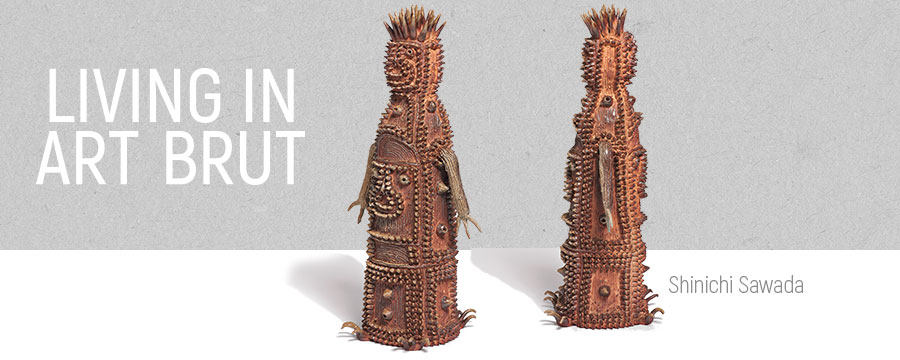The term Art Brut
Art Brut is the term coined by Jean Dubuffet in 1945 to describe “raw art”, outside the academic tradition of fine art. Brut means not only raw; it is also analogous to champagne, for Dubuffet was a wine merchant as well as an artist. The creators of these works have not been to art college, and they have no interest in cultural trends. During his lifetime Jean Dubuffet assembled a huge collection, which he donated to the city of Lausanne in 1971. The Collection de l’Art Brut is the oldest Art Brut museum in the world.
In Art Brut the emphasis is always on the quality of the artistic expression, which is based on “individual mythologies” (Harald Szeemann). Each artist has his or her own visual language, unaffected by convention. Social status, personal background or mental, physical and intellectual state are irrelevant when evaluating the aesthetic criteria. Art Brut is concerned with creativity on the margins of society. In essence Art Brut refers to art by people with psychiatric experience or a disability, art that is mediumistic – i.e. guided by a spirit – or created by social outsiders. It is important to me to appreciate each of the artists in the context of his or her own fate.
In 1972 Roger Cardinal coined the expression “Outsider Art”, which then became popular in the Anglo-American world.
The story of Art Brut
Although we can find examples of Art Brut in psychiatric clinics as early as the 19th century, the story really begins with the publication of two books that played a key role in the dissemination of Art Brut amongst artists and psychiatrists.
1921 saw the publication of a book about Adolf Wölfli, Ein Geisteskranker als Künstler (A Psychiatric Patient as Artist), that made Wölfli famous, as well as the author Walter Morgenthaler, who was his psychiatrist at the Waldau Clinic in Bern.
In 1922 the art historian and doctor Hans Prinzhorn published Bildnerei der Geisteskranken (Artistry of the Mentally Ill). His research was based not only on the collection already held by the psychiatric clinic in Heidelberg, but also on more than 5,000 works from psychiatric institutions all over Europe, which he had sent to him for his research work. This is the famous Prinzhorn Collection, now a museum at the university hospital in Heidelberg.
Later, the artists of the avant-garde movement, followed by the surrealists (e.g. Max Ernst, Salvador Dali, Hans Bellmer) were influenced by artworks created in psychiatric institutions, and found inspiration in their unaffected authenticity. Pablo Picasso, Jean-Michel Basquiat and David Bowie were all collectors of Art Brut.
The Gugging Phenomenon
Gugging is the centre for Art Brut in Austria. In 1949, psychiatrist Leo Navratil joined the staff of the psychiatric clinic in Gugging, just outside Vienna. In 1965 he published Schizophrenie und Kunst (Schizophrenia and Art). In 1981 he founded
the world famous “House of Artists” (initially called the “Centre for Art and Psychotherapy”) as a men’s psychiatric ward.
As early as 1969 he sent drawings by his patients to Jean Dubuffet, who accepted these as Art Brut. In 1970 works by the Gugging artists were exhibited for the first time in Monsignore Otto Mauer’s Galerie (nächst) St. Stephan in Vienna. Numerous artists visited Gugging, including Eduard Angeli, Adolf Frohner, André Heller, Peter Pongratz, Arnulf Rainer and Gerhard Roth. In 1990 the Gugging artists received the Oskar Kokoschka Prize, Austria’s highest award for contemporary art.
Gugging has now developed into a unique centre for Art Brut, with art production facilities, a museum and gallery. Psychiatrist and artist Johann Feilacher, who succeeded Leo Navratil, separated the House of Artists from the psychiatric clinic, and developed the artists’ community into a social welfare institution. In 2006 the museum gugging was opened. He let the term “patient” become obsolete. The basic criterion for admission is artistic talent.
Art Brut and the zeitgeist
“Art Brut has always existed, but nobody paid any attention to it.” So says Arnulf Rainer, one of Austria’s foremost artists and perhaps the greatest collector of Art Brut in the country.
We are currently in the middle of a phase where Art Brut is receiving more and more attention all over the world. Since the market for Art Brut is just as much subject to the economic dynamics of change as any other area of society, Art Brut is increasingly becoming a “business”. The traditional boundaries between Art Brut and “high art” are shifting. As a result, Art Brut has repeatedly moved from the margins into the focus of the international art world, for example in the central pavilions at the Venice Biennale in 2013 and 2017. Since the turn of the millennium numerous Art Brut museums have opened all over Europe. Private collections are increasingly being opened to the public.
I am working to convince today’s art historians, gallery owners, auction house assessors and curators that Art Brut should have equal status in the world of contemporary art.


